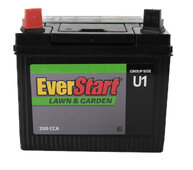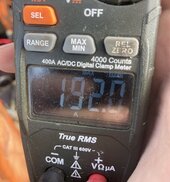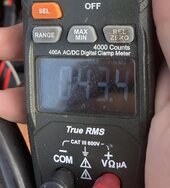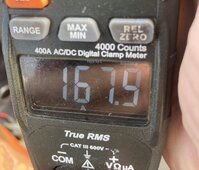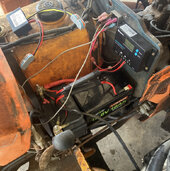Vigo
Solar Addict
Recently I needed to replace an FLA battery in my little 600cc diesel Kubota tractor. I could have done the ~$34 thing and just bought another U1 riding mower battery from Walmart, but i wanted to turn it into an experiment instead. When i looked at lifepo4 options to use as an engine-cranking 'starter' battery, my prime suspect was a 12v 50ah model with a 50a bms for ~$100. But, I considered it dubious whether a 50a BMS would be reliable in terms of cranking an engine without tripping, and i was definitely not in the mood of spending $200 for a 100ah model and 100a bms that would have just, you know, solved the problem in one fell swoop. So instead of spending $200 for 100ah or $100 for 50ah i spent basically $100 on WAY LESS than 50ah of lifepo4 to test some concepts. Huh?
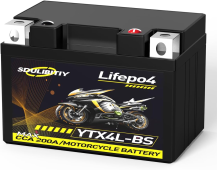
~$40 on amazon
So 'powersports' / motorcycle lifepo4 starting batteries on Amazon are getting down into the $40-60 range. They are 'rated' for 200-300 'cold cranking amps' in that price range, and are only 2-6ah of capacity! I assume they are simply some tiny but otherwise 'normal' lifepo4 cells hooked to a relatively monstrous BMS, and cycle life be damned (but still claim 2000-8000 because who will stop you!?). I have not opened one to verify. But I found a ~$40 2ah model rated for 200a and bought it. The model i bought, i found disappointing. My little tractor takes about 130-180a in current conditions (it was 70f today) and the battery would only crank it intermittently. I do not have an inrush meter but i know that if one were to scope a starter motor's current waveform it has an enormous but very brief spike before quickly dropping to 'steady' cranking amps. Unfortunately in this case, the bms electronics are fast enough to catch that and disconnect before the current drops off to the level the BMS is rated for. Even when the bms makes it across that jump and cranks the engine, I only get 1-2 good seconds of cranking before the BMS trips again. Put one way, it is WAY LESS of a cranking battery than the $37 lithium 'jump pack' i bought a couple of months ago. So, disappointing.
But i never really intended to put a 2ah battery alone in my tractor. I wanted a bit more margin for error than that, such as if i run the thing out of diesel and have to crank the engine to purge the air from the injection lines before it will start again. So I had the thought of paralleling a larger ah battery to the tiny motorcycle battery so that it would 'contribute' to some extent during cranking, but mostly 'add capacity' to the starter battery by transferring charge to it pretty rapidly, giving me many good long cranking attempts, only perhaps requiring some decent pauses in between.
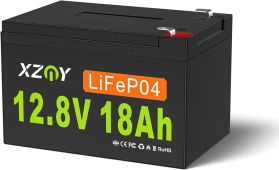
Was ~$41 when i bought it
For this purpose i bought an 18ah battery for ~$41. I figured if this didn't work out it would go in one of the little electric cars for my 2 & 5 year old daughters, lol. I believe it has either a 15 or 20a continuous rated BMS. With this whole engine-cranking thing we are spending all our time not in the continuous rating, but in that 1s-5s duration rating that not many rock-bottom-money Amazon listings even mention. There is not even ROOM for a 200a bms in the 200a rated battery, so i believe the 'cranking amps' number these listings are using is really something at or under that 1-5 second rating we see specified on higher quality products. Anyway, I put a 100amp load tester to this 18ah battery and it consistently immediately tripped the bms. However, my theory for why the bms wouldnt trip during engine cranking was because my parallel connection to the other battery would be no larger than 12ga, which would 'throttle' the current sufficiently to stay in that 1-5 second rating region until the cranking was over. So, i hooked the 100a load tester through some 12ga wire and the 18ah battery did 75 amps for a solid 5+ seconds, and i lost my nerve and let off to see if my 12ga was getting too hot, before the bms actually tripped. So far so good!
Once the two batteries were in parallel in the tractor with 12ga wiring in between, it DID work out basically as i thought, with the caveat that the 2ah bms still occasionally tripped. When it didn't, the batteries cranked the engine fast and plenty long enough, and i didn't have the patience to see how many 'good long cranks' i could get out of it but it was definitely enough. I measured both batteries together to crank the engine fast at 180a with 75a of that coming from the 18ah, and the 2ah alone (18ah disconnected) cranks the engine a bit sluggishly at 133a.
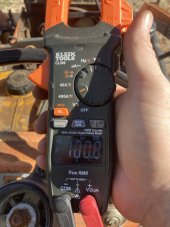


I consider my idea to be viable, with the exception that the 2ah 'starter' battery (really just its internal bms) is slightly undersized for this task. Im returning it (hey, it says 200 cranking amps and won't consistently do 130 without tripping) in favor of a slightly larger 300a rated 5ah model for ~$12 more, and keeping the 18ah. At that point i expect the thing to be fine. I didn't save any money over buying a $100 50ah model that might have worked out fine and had more capacity, but i verified some thinking about how this whole parallel balance between two different size BMS's and ah capacities would work out.

Theres a pic of the two tiny batteries sitting in the battery tray of the Kubota B6100. Don't hate on my Renogy there, it's the cheapest ($16) SCC that is specifically negative ground. It's being fed by a 5w solar panel and the AC dynamo of the engine (after passing through that little rectifier block there). It's a whopping FIVE amp charging system at redline! Below half throttle it doesn't charge at all! Finally, if anyone is worried about low temp charging protection, I can assure you i live in South Texas and i will not be getting on this tractor when it is below freezing!
Here is the replacement starter battery i am waiting on:
This one's rated 320a...


~$40 on amazon
So 'powersports' / motorcycle lifepo4 starting batteries on Amazon are getting down into the $40-60 range. They are 'rated' for 200-300 'cold cranking amps' in that price range, and are only 2-6ah of capacity! I assume they are simply some tiny but otherwise 'normal' lifepo4 cells hooked to a relatively monstrous BMS, and cycle life be damned (but still claim 2000-8000 because who will stop you!?). I have not opened one to verify. But I found a ~$40 2ah model rated for 200a and bought it. The model i bought, i found disappointing. My little tractor takes about 130-180a in current conditions (it was 70f today) and the battery would only crank it intermittently. I do not have an inrush meter but i know that if one were to scope a starter motor's current waveform it has an enormous but very brief spike before quickly dropping to 'steady' cranking amps. Unfortunately in this case, the bms electronics are fast enough to catch that and disconnect before the current drops off to the level the BMS is rated for. Even when the bms makes it across that jump and cranks the engine, I only get 1-2 good seconds of cranking before the BMS trips again. Put one way, it is WAY LESS of a cranking battery than the $37 lithium 'jump pack' i bought a couple of months ago. So, disappointing.
But i never really intended to put a 2ah battery alone in my tractor. I wanted a bit more margin for error than that, such as if i run the thing out of diesel and have to crank the engine to purge the air from the injection lines before it will start again. So I had the thought of paralleling a larger ah battery to the tiny motorcycle battery so that it would 'contribute' to some extent during cranking, but mostly 'add capacity' to the starter battery by transferring charge to it pretty rapidly, giving me many good long cranking attempts, only perhaps requiring some decent pauses in between.

Was ~$41 when i bought it
For this purpose i bought an 18ah battery for ~$41. I figured if this didn't work out it would go in one of the little electric cars for my 2 & 5 year old daughters, lol. I believe it has either a 15 or 20a continuous rated BMS. With this whole engine-cranking thing we are spending all our time not in the continuous rating, but in that 1s-5s duration rating that not many rock-bottom-money Amazon listings even mention. There is not even ROOM for a 200a bms in the 200a rated battery, so i believe the 'cranking amps' number these listings are using is really something at or under that 1-5 second rating we see specified on higher quality products. Anyway, I put a 100amp load tester to this 18ah battery and it consistently immediately tripped the bms. However, my theory for why the bms wouldnt trip during engine cranking was because my parallel connection to the other battery would be no larger than 12ga, which would 'throttle' the current sufficiently to stay in that 1-5 second rating region until the cranking was over. So, i hooked the 100a load tester through some 12ga wire and the 18ah battery did 75 amps for a solid 5+ seconds, and i lost my nerve and let off to see if my 12ga was getting too hot, before the bms actually tripped. So far so good!
Once the two batteries were in parallel in the tractor with 12ga wiring in between, it DID work out basically as i thought, with the caveat that the 2ah bms still occasionally tripped. When it didn't, the batteries cranked the engine fast and plenty long enough, and i didn't have the patience to see how many 'good long cranks' i could get out of it but it was definitely enough. I measured both batteries together to crank the engine fast at 180a with 75a of that coming from the 18ah, and the 2ah alone (18ah disconnected) cranks the engine a bit sluggishly at 133a.



I consider my idea to be viable, with the exception that the 2ah 'starter' battery (really just its internal bms) is slightly undersized for this task. Im returning it (hey, it says 200 cranking amps and won't consistently do 130 without tripping) in favor of a slightly larger 300a rated 5ah model for ~$12 more, and keeping the 18ah. At that point i expect the thing to be fine. I didn't save any money over buying a $100 50ah model that might have worked out fine and had more capacity, but i verified some thinking about how this whole parallel balance between two different size BMS's and ah capacities would work out.

Theres a pic of the two tiny batteries sitting in the battery tray of the Kubota B6100. Don't hate on my Renogy there, it's the cheapest ($16) SCC that is specifically negative ground. It's being fed by a 5w solar panel and the AC dynamo of the engine (after passing through that little rectifier block there). It's a whopping FIVE amp charging system at redline! Below half throttle it doesn't charge at all! Finally, if anyone is worried about low temp charging protection, I can assure you i live in South Texas and i will not be getting on this tractor when it is below freezing!
Here is the replacement starter battery i am waiting on:
This one's rated 320a...

Last edited:





